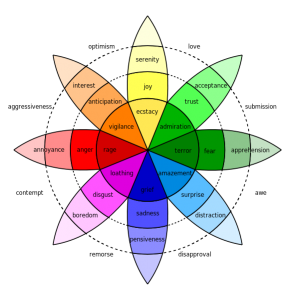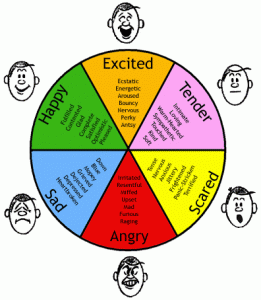How are your characters feeling? It’s important for your readers to know. I’ve written an earlier post about conveying a character’s thoughts, and another one about facial expressions, but it’s time to tackle emotions.
For this blog post I’m going to regard ‘feelings,’ ’emotions,’ and ‘moods’ as being synonymous, even though neuroscientists draw distinctions between these terms.
Emotions are part of the human experience, and seem to result from how we’re hard-wired, what our individual background has been, and a recent external or internal stimulus. Since we all have emotions in the real world, the characters in your fiction must have them too, to make them convincing.
Whether there are six basic emotions, as depicted by Dr. Paul Ekman…
…or eight as pictured by Dr. Robert Plutchik…
 …writers just need to know there are many emotions, and characters can feel them in combinations and in various intensities.
…writers just need to know there are many emotions, and characters can feel them in combinations and in various intensities.
As a writer, it’s your job to convey these emotions to the reader with clarity and accuracy. There shouldn’t be a doubt in the reader’s mind about what a character is feeling.
How do you do that? Here are some guidelines to follow:
- Make sure the emotion is appropriate. Remember, it’s based on a character’s background, but is also a response to a recent stimulus.
- Show the emotion through the character’s actions: speech (not only what is said, but word choice and tone of voice), facial expressions, hand motions, or body posture.
- Show the emotion by describing the character’s thoughts or mental state.
- Use metaphors and similes, but shun clichés.
- In certain situations (fast action scenes, very short fiction, or if applicable to a minor character or sub-plot), just tell the character’s emotion. This is not as effective as other methods and indicates amateurish writing if used too often.
If you get stuck trying to portray a character’s emotion in words, one technique that might help is to recall a time when you had that feeling yourself. See if you can draw on that memory and maybe even recreate the emotional state within yourself. If you can conjure up within yourself the same emotion your character is feeling, you stand a good chance of finding words to describe it.
There are some helpful websites that list adjectives useful in describing emotions, notably this one and this one. But I caution against an over-reliance on such adjectives. It’s more effective to show emotions through a character’s actions or by describing what’s going on inside the character’s mind.
How did this blog post make you feel? Are you now confident you can convey a character’s feelings in a more precise way? I welcome comments from you on this topic; in fact few things in life bring greater joy and serenity to—
Poseidon’s Scribe

